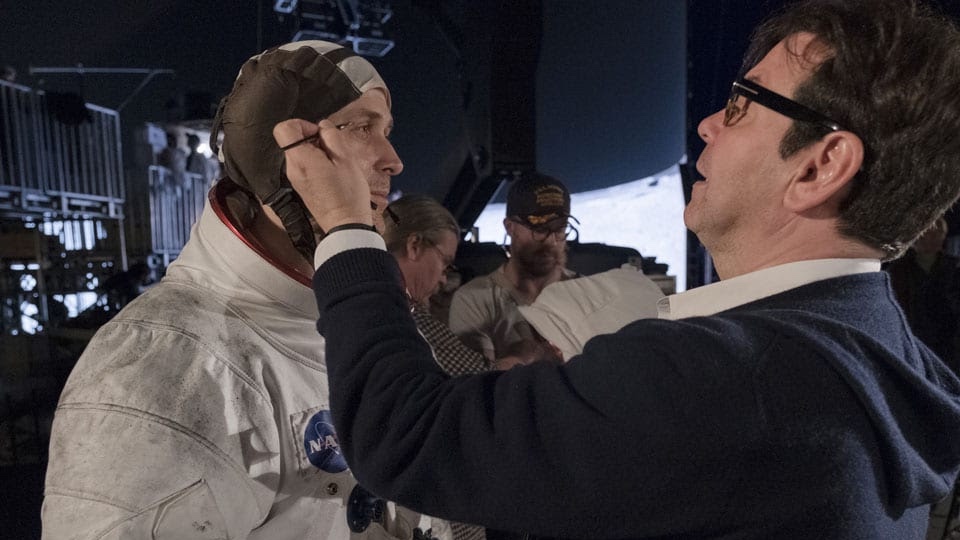
One policy I’m going to take with this writeup is not to over-discuss the obvious stuff – Panasonic’s AG-3DA1 camera is massively covered elsewhere, and $21k for something that really feels like a consumer camcorder seems steep even if it does have two lenses. I think it’s much more interesting to talk about the smaller stuff that’s easy to overlook if you didn’t make it to Vegas – people like Indie Cam (www.indicam.com). These guys have a set of camera heads that’ll give you either raw recording to their own stereo file recorder, or either raw or RGB/YUV over SDI. It is so compact that they were able to show a 3D camera system, the indieTWIN, without having to bolt it all to a huge clumsy mirror rig, which is what everyone else was doing. It’s not impossible to imagine circumstances where this gear could eventually be applied to live broadcast as well.
While we’re talking about mirror rigs, we should mention 3ality Digital (www.3ality.com), much in evidence on various camera manufacturers’ booths, who gave a presentation on the lessons learned from recent 3D work that was absorbing, terrifying and painful in equal parts. I’m one of those awkward 15 percent of people for whom 3D will always be a source of headaches, possibly – we suspect – because certain people can’t separate focus distance from convergence distance, and there may be no solution to this. For the lucky remainder, though, 3ality were able to use their servo-actuated camera mounts to amply demonstrate how to avoid those problems that are actually avoidable. The 3ality mirror rigs are the sort of gorgeous engineering that’s conjured into shape by sorcerers and polished on maidens’ kneecaps, but it’s hard to think of them as anything other than a workaround since a large proportion of their work is in evening out inconsistencies between camera-lens pairs. One representative of a large UK broadcaster told me that they weren’t particularly keen on the amount of seats they’d need to book out of a sports venue to hold these bulky rigs, or on the amount of time it takes to set up and tear down.
In the end 3D felt like a bit of a damp squib, with everyone shouting that they wanted to do it, but waving around fistfuls of absolutely no money at all in order to fund it. Even Thompson were “not betting the farm on 3D.” It is clearly possible to build systems that will do it, and eventually in a format more convenient than a mirror rig. The problem is economic, and it isn’t entirely (or even largely), due to the world economic situation. The broadcasters seem to be modeling the introduction of 3D on the introduction of HD which is an uncomfortable comparison for people who often see HD as not having increased revenue as much as they’d hoped it would, and who also see 3D as being far more unsure bet.
In the feature world, with a greater tolerance for high-maintenance camera systems and the recent success of some movie or other involving blue people, things seem to be clearer cut. All the same, there’s very little specific technology out there – at least, so little technology that doesn’t involve duct-taping two cameras to a plank. I think the world remains to be convinced that it isn’t a zero-sum game.
So, the state of 3D: Wait and see. Again. Sorry.
Still, we shouldn’t be scowling at the Central Hall exhibits in this unseemly manner. There’s all kinds of amusing new camera toys to look at, from Canon’s DSLRs, to Panasonic’s interesting but very much pre-release AG-AF100 that’s clearly designed to compete with Red. Way down the other end of the hall we’ll find Sony and their new F… F-thingy… oh, whatever it is, it’s something anyone who owned an F23 and an SRW1 could approximate with a roll of duct tape. It’s big and ugly and very expensive and probably works very well, although I’m sure if I’d spent several hundred thousand units of currency with Sony on the aforementioned F23 combo, I’d be a bit dismayed at their constant need to push out new products into what’s really a very small market.
The Canon guys are still convincingly feigning surprise at finding out what happens if you make a big-chip camcorder that records to flash and sell it for $2k. I’m waiting with some enthusiasm for their stills and video guys to put their heads together, solve the three big obvious problems, and come up with something we could reasonably call “Red killer,” but it’s actually quite difficult to figure out what they are selling right now. Fashionable DSLRs are currently wearing so many gleaming designer accessories that it’s difficult to see the camera underneath, and I suspect that the real winners in this scenario are outfits like Cinevate who make accessories. It’s very easy to take a small, unobtrusive, light camera like a T2i and add so much wobbling miscellany that it is no longer any of those things, then find you’ve spent more than it would take to buy a camera like an EX3. And the EX3 won’t embarrass you so badly if you aim it at a zone plate chart – or a chain link fence. Or some text. Or someone with hair.
Bored with DSLRs, let us trek through the acres of people promoting LED lighting solutions. There really is an absolute ocean of this stuff, from no-name far-eastern manufacturers to the gleaming blue anodizing of OutSight’s CreamSource (www.outsight.com.au). Not sure about the name, but this has to be the most over-technologized piece of gear I’ve ever seen – it has an actual menu system – and provides, by OutSight’s literature, “as much output as a 575W HMI.” It produces the usual projecting softlight that LEDs seem to do well, but there’s a shopping list of extra features including one that I’ve actually had to build in the garage in the past – shutter-synced strobbing chief among them. Much as I disapprove in general of rolling shutter cameras, it is at least nice to know you can hit a button and the proceeding flash will actually be photographed over the entire frame. Nice as it is, though, I thought that most of the LED lighting on display had a similar problem: they want far too much money for what isn’t particularly exotic technology. On the upside, they have a very cool toy on their website providing visual comparison of their product with others, so that’s OK then.
Donning our lead-lined underwear, let’s sprint past the people attempting to microwave the clouds with satellite uplink exhibits, towards the unruly mob clustered around the Blackmagic Design booth. Second largest in the show, according to stalwart UK rep Callum McLay, and abuzz with talk about Blackmagic’s purchase of Da Vinci. The end of bespoke hardware-oriented color correction devices had been widely anticipated among, well, anyone who’s played a computer game in the last ten years, and the news is that you can now get Da Vinci Resolve for your Mac, for $1k. A closer look reveals that to run the thing across a large amount of nodes, for better performance, you still need to buy the Linux version that with the required control surface will set you back $50k plus hardware. Still, this new situation at least provides competition that might make Color get its act together a bit. More than that, it offers a solution for the high end whose price is a bit more related to the fact of what it actually does, in a world where the feature set of desktop software like After Effects makes the basic work of grading look pretty trivial.
Walking the floor at NAB is the sort of activity that leaves imprints of the inside of your shoes on your feet until the following morning. So, let’s retire from the show floor in the company of a few dozen other wincing journalists and enjoy some ludicrously jumbo-sized tiger prawns in the company of one of the world’s larger media equipment manufacturers. It’s always really difficult to write about these press conferences, because outfits like Harris have such a massive range of products and services that they’re forced by circumstance to talk in very general terms. There’s a degree of corporate “group think” at work here, I think, and the conservatism that comes with any big deal corp, but most of these speeches could be reconstructed from a page of Bullshit Bingo (see bullshitbingo.net, seriously!). They get a mention here only because of their victory in the hotly-contested NAB Media Corps Best Buffet Award 2010, judged by me, and because their broadcast division is now run by someone whose given name is actually Harris.
Back on the floor, in a desperate last-minute search for people who make things that are interesting, we find Uniq Optics (www.uniqoptics.com) showing two sets of prime lenses, including a PL series “for S35+” and a set in Canon mount designed for the 7D. Apparently the PL set has been on the cards since before Red became popular, but I’m sure both Uniq and competing outfits like Luma Tech (www.lumatechinc.com) are very pleased to see the world demand for PL lenses multiply beyond all recognition. Right now there are a lot of people trying gamely to shoot 4K on ancient lens sets that couldn’t, technologically speaking, count to four or spell “K.” Luma seem to have a close relationship with LOMO in Russia, who’ve been turning out the kind of glass that people put on Konvas 2Ms since 1912. To be fair, they have in that time created a lot of glass you wouldn’t use to set fire to blameless insects, but they’re now pushing a new series of Illumina S35 lenses based on entirely new technology, right down to the optical glass stock. Frankly, the Uniq stuff looked more nicely done and Kenji Suematsu is a true gentleman of engineering, but at the end of the day you can get what look to be a workable set of primes from either of these people for much less than $35k. Anyway, I can’t really sign off this paragraph without mentioning Luma’s nice little toy for checking flange focus distance on PL-mount digital cameras. It’s a microscope, (true to LOMO’s heritage as an manufacturer of scientific instruments), that sits in the lens mount and actually allows the technician to image the photosites on the sensor. It is, appropriately, quite illuminating to stand there in front of a Red looking into an eyepiece at what is clearly an array of red, green and blue Bayer filters, thinking: so that’s what a really noisy sensor looks like.
It wasn’t a bad NAB, given the economic situation. Quality of press freebies was a little down on the average, but I managed to go three days without paying for food or drink and in Vegas that’s not bad going. Most people seemed to be doing their best to brazen-out any financial downturn, which is quite heartening, really: that’s what we all should be doing to bring any troubles that do exist to a swift conclusion. Excepting the vaporware and general hot-air about stereoscopic 3D, it was packed with stuff not entirely expected and stuff at agreeable price points. I’m writing this in the UK and at least here the worst fiscal nukes may be yet to go off, so I’ll reserve further judgment until next year.






[…] this link: NAB 2010 | Below the Line Agregar a […]
[…] NAB 2010 | Below the Line […]